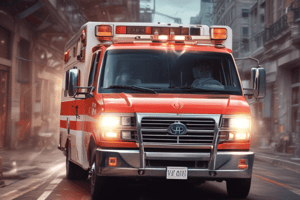Podcast
Questions and Answers
What is the priority when a life-threatening condition is identified in a patient?
What is the priority when a life-threatening condition is identified in a patient?
- Contact the patient's family
- Administer pain medication
- Perform immediate life-saving interventions (correct)
- Perform additional assessments en route
In which scenario should patient transport be delayed according to the text?
In which scenario should patient transport be delayed according to the text?
- When a patient has an unstable pelvic injury
- When a patient is experiencing severe chest pain
- When a patient is having an epileptic seizure
- When a patient has a decreased level of responsiveness (correct)
What is an example of an immediate transport emergency as mentioned in the text?
What is an example of an immediate transport emergency as mentioned in the text?
- Childbirth complications
- Fractured Femur (correct)
- Non-emergent chest pain
- Severe hypothermia
When should a patient's medications be transported with the patient?
When should a patient's medications be transported with the patient?
Why is it generally best to keep an injured patient in the position you find them?
Why is it generally best to keep an injured patient in the position you find them?
In what situation might moving a patient be beneficial according to the text?
In what situation might moving a patient be beneficial according to the text?
What is the first step to be taken when responding to an emergency according to the text?
What is the first step to be taken when responding to an emergency according to the text?
Which assessment should be prioritized initially when responding to an emergency?
Which assessment should be prioritized initially when responding to an emergency?
Why is it emphasized not to make assumptions at an emergency scene?
Why is it emphasized not to make assumptions at an emergency scene?
Which indicator should responders look for to understand what may have happened at an emergency scene?
Which indicator should responders look for to understand what may have happened at an emergency scene?
In which circumstances should a full head-to-toe assessment be considered necessary according to the text?
In which circumstances should a full head-to-toe assessment be considered necessary according to the text?
What is the main purpose of a rapid body survey in emergency response?
What is the main purpose of a rapid body survey in emergency response?
Where should you place your fingers to find an infant's pulse?
Where should you place your fingers to find an infant's pulse?
What does the term 'circulation' refer to when checking a patient's ABCs?
What does the term 'circulation' refer to when checking a patient's ABCs?
When should pulse oximetry be applied to a patient?
When should pulse oximetry be applied to a patient?
Where is the brachial artery located in relation to an infant's arm?
Where is the brachial artery located in relation to an infant's arm?
What action should be taken if no pulse is detected after 10 seconds?
What action should be taken if no pulse is detected after 10 seconds?
Which patients should have pulse oximetry applied?
Which patients should have pulse oximetry applied?
Why is the first hour after an injury often referred to as the Golden Hour?
Why is the first hour after an injury often referred to as the Golden Hour?
Why is reassessment considered important in patient care?
Why is reassessment considered important in patient care?
When should reassessing a patient's ABCs occur according to the text?
When should reassessing a patient's ABCs occur according to the text?
What is the purpose of performing a rapid body survey as mentioned in the text?
What is the purpose of performing a rapid body survey as mentioned in the text?
Why is a secondary assessment conducted in patient care?
Why is a secondary assessment conducted in patient care?
What is the main reason for ensuring that reassessment is an ongoing process according to the text?
What is the main reason for ensuring that reassessment is an ongoing process according to the text?
What is the first step in testing a patient's blood glucose level using a glucometer?
What is the first step in testing a patient's blood glucose level using a glucometer?
Why is insulin important in the process of glucose transfer to the body's cells?
Why is insulin important in the process of glucose transfer to the body's cells?
Why is it important to allow the skin to dry completely after wiping the patient's finger with an alcohol swab?
Why is it important to allow the skin to dry completely after wiping the patient's finger with an alcohol swab?
What should be done immediately after documenting the blood glucose test results?
What should be done immediately after documenting the blood glucose test results?
What purpose does a glucometer serve in managing diabetes?
What purpose does a glucometer serve in managing diabetes?
Why is it necessary to dispose of used lancets and test strips properly in a biological waste container?
Why is it necessary to dispose of used lancets and test strips properly in a biological waste container?




